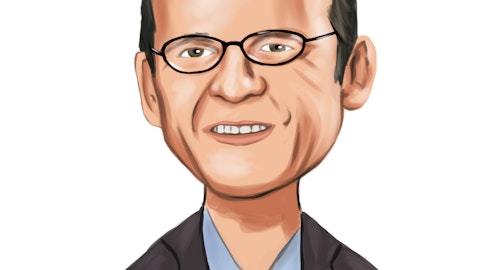Because that’s when they can get to count on it. So that’s what I would say they would tell us is a big difference. They see that in us. They don’t see the same continuous improvement. They don’t see the same approach to making sure the same process of measurable and controllable across the sites. And finally, what I would add in there is engagement, employee engagement. We’ve just recently finished a survey that came back very strong from our employees. And that’s a very important to this market. At the end of the day, hourly employees do the work of moving these products. And what they also saw was that we are heavily engaged. They hear it from our employees. They see it as they walk through our sites. And that engagement is something that is very important to us and very critical to our success.
Allison Poliniak: Got it. Thank you.
Operator: Thank you. Our next question comes from the line of Jason Seidl with TD Cowen. Please proceed with your questions.
Jason Seidl: Hey, thank you, operator. Good morning, gentlemen. And a special congrats to Adrian for his new role. Adrian, I know we talked a little bit about this in the past. I mean, you guys are utilizing some AI already in your network and having some success and putting that new technology to use. Can you talk a little bit more about it and then how you think that could be used to even win further customers down the road?
Mark Manduca: Hey, I’ll stop there. It’s Mark here. Adrian is not with us today, but only in spirit, exactly in spirit. It’s been part of our DNA for a while. AI is very important to us. We’ve been working on this for five years. This is not something that has arisen in this business in the last six months. Long duration. We’ve got significant scale as we talked about on this call in a very fragmented market. And that scale from an artificial intelligence standpoint, and obviously the data that that scale yields makes us a very likely winner in this arena going forward. So, it’s an area of huge excitement for us. And I think it’s going to be an area that’s going to drive a lot of accuracy and efficiency for customers going forward. Bill, do you want to talk about some specifics?
Bill Fraine: Yes. I’ll give you some examples. And as Mark mentioned, it’s really in our DNA. We’ve worked for years with analytics with our customers. So if you look at how we handle returns or how we handle processes inside the site. We’re always we have a heavy analytics group that’s looking at these numbers and following these numbers. And it’s how we improve. It’s how we learn. It’s how we manage returns at a better pace. We can see the products that are coming in and pre-positioned to make it more seamless and productive for the customer and get the best value back to them as I mentioned moving these days. So, what AI does is it takes that same data and it starts to automate it. It puts it through some systems and we’ve already begun that in few different areas.
And it helps us redesign transportation networks. It helps us improve automation productivity. So, the AI will look at the data coming out of the automation and it will help us decide how best way to move products and what products, as I mentioned earlier. And finally, we use it to handle even areas like how we pack. how we make the best use out of packaging, which lowers the cost for the customer and improves on ESG.
Jason Seidl: I appreciate the color on that. And I guess my follow-up is going to be something that really we haven’t talked about too much because, jeez, you guys are recording record wins, who would be talking about the M&A side. But does all this new growing business, does that put potentially M&A on the back burner? Or is this something you guys are still looking at? And maybe if you are, could you talk about what you’re seeing out there in the market in terms of multiples?
Malcolm Wilson: Jason, hi, it’s Malcolm. Let me touch on that. And I’ll ask Baris to comment on the multiples point. But from an M&A point of view, as you can see, our business, we’re really growing at a stellar volume. We’re taking market share, customers really want to work with GXO, level of automation. That’s really why we, just appointed Adrian. So overall, we’re in really great shape, but we have to recognize sometimes there are vertical specialization on the geography specialization where customers really want to see what you’re doing on the ground. And when you’re not on the ground, it’s very difficult to convince customers to come across to you. And that’s typically where we’re focused on an M&A route. That’s where we design our M&A pipeline.
It’s where we look out for best opportunities when we think about margin accretion, customer growth. And that’s typically how we look at things. So that’s very much the direction that we have. No need from our business perspective to do M&A to grow scale. We’re already the largest, pure play in the world, but very much looking at different vertical specialization. And Baris, maybe you can just give a view of what we’re seeing around from a verticals perspective in terms of multiples and the like.
Baris Oran: What we are focusing on right now is where we can have additional capabilities, additional customer relationships, additional geographies. We have — we’re looking into additional capabilities in North America, including Canada and Mexico, And that does include value added services as well that we can expand further to our customers. We have a sizable pipeline in Germany. If you’re looking into potential acquisitions in Germany as well. But our cash flow generation, our deleveraging is at the heart of what we do right now. And we always look at this as an alternative to invest in our own stock through a buyback. And we always compare that and see if it makes sense for our shareholders, if it pays off for our shareholders.



